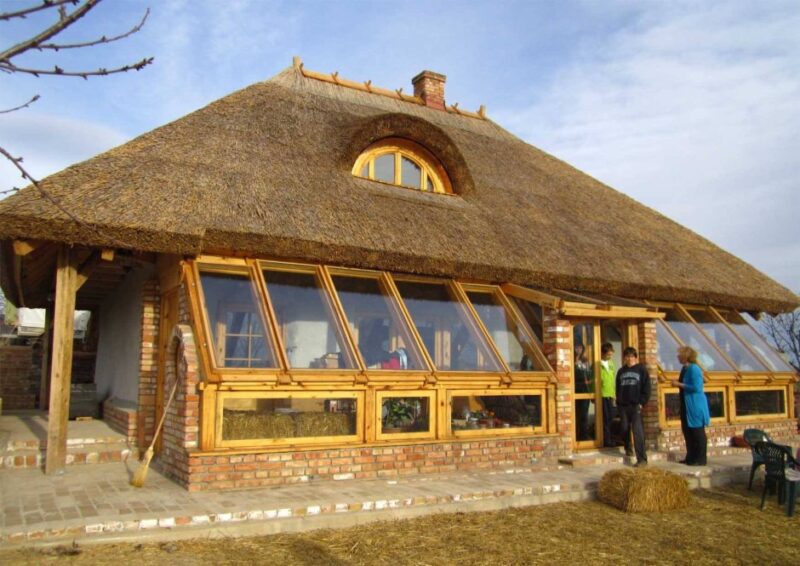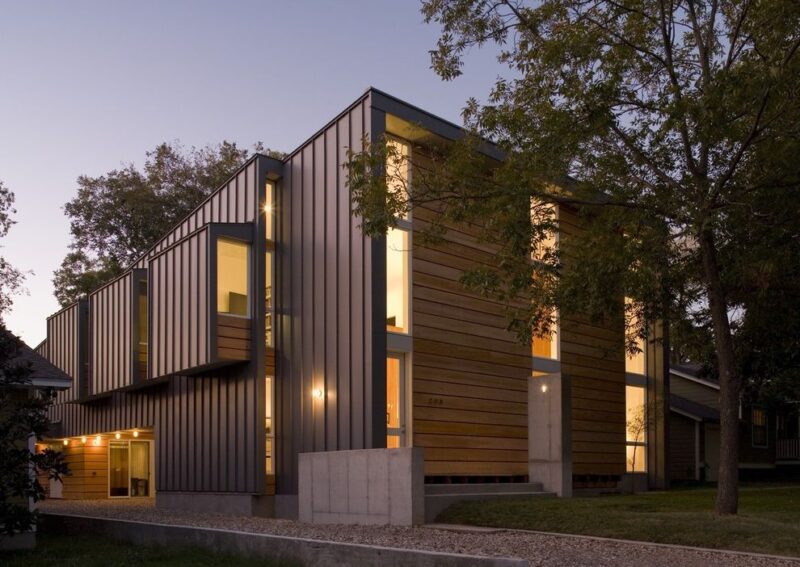Facade, as the exterior part of a building, plays a very important role in its beauty and overall appearance quality. One of the popular types of facades is the wooden building facade. In this article, we will examine practical tips for constructing and installing wooden building facades.
Types of Wooden Building Facades

Types of Wooden Building Facades
- Open-Joint Cladding: In this type of facade, gaps are left between the wooden panels to allow air passage and water penetration. This type of facade allows the building to breathe and prevents the accumulation of moisture.
- Shingle Cladding: In this type of facade, long and narrow wooden pieces are overlapped and placed on the surface of the building. This facade adds shape and beauty to the building and can be executed in various designs and patterns.
- Flat Cladding : In this type of facade, flat and straight wooden pieces without any curvature or bends are placed on the surface of the building. This facade gives the building a sleek and modern appearance, making it suitable for minimalist designs.
- Panel Cladding : In this type of facade, large wooden sheets are arranged in the form of big panels, giving the building a cohesive shape and structure. This facade provides the building with a modern appearance and harmony between the wooden elements.
- Composite Cladding : In this type of facade, wooden pieces are combined with other materials such as metal, glass, or stone. This combination can give the building a unique and distinctive appearance.
Timber Frame Facade
The timber frame facade is one type of wooden building facade where some of the structural elements are directly connected to the ground. This type of facade can enhance the building’s beauty and strength.
Sheet Wood Facade
Sheet wood facade refers to wooden sheets that are installed on the building. This type of facade gives the building a charming and warm appearance.
Suspended Facade
A suspended facade is a type of facade where the building elements are independently attached to the facade rather than being connected to the ground. This type of facade gives the building a light and modern appearance.
Advantages of Wooden Buildings

Advantages of Wooden Buildings
- Lightweight and Low Weight: Wood is known as a lightweight and low-weight material. This feature allows wooden buildings to be constructed more quickly and at a lower cost.
- Durability and Strength: Wood, when using the right type of durable and sustainable wood, can provide suitable resistance and strength. This feature enables wooden buildings to withstand external forces and earthquakes.
- Connection with Nature: Using wood in buildings creates a warm and natural connection with the environment. The warmth and natural feel of wood attract people and contribute to a sense of calm and inner peace.
- Thermal and Acoustic Insulation: Wood acts as a thermal and acoustic insulator. Wooden buildings can effectively control temperature and sound within the building, optimizing the environment.
- Recyclability and Biological Sustainability: Wood is a renewable and recyclable resource, contributing to biological sustainability. Using wood instead of non-recyclable building materials has a positive impact on reducing pollutants and greenhouse gas emissions.
- Short Construction Time: Wooden buildings, due to their lightweight and prefabrication methods, have a shorter construction time compared to traditional buildings. This can lead to reduced costs and shorter project execution times.
- Easy Design and Layout: Wood is easily flexible and shapeable, allowing designers and architects to create innovative facades and structures. This allows designers greater freedom in designing the building’s facade.
Disadvantages of Wooden Buildings:
- Susceptibility to moisture: Wood has the ability to absorb and release moisture. Therefore, wooden buildings may be sensitive to water and moisture infiltration. Proper protection of wood against moisture and the use of appropriate insulation methods are necessary.
- Susceptibility to fire: Wood is a combustible material and is at risk of catching fire. This necessitates the use of fire protection measures, fire detection and suppression systems, and adherence to safety standards in wooden buildings.
- Susceptibility to pollution and pests: Wood may be susceptible to pollutants, fungi, insects, and pests. If not properly protected and maintained, wood may become contaminated and deteriorate over time due to environmental conditions.
- Need for maintenance and repair: Wooden buildings require periodic maintenance and repairs. This includes protecting wood from moisture, pollution, and pests, as well as repairing and replacing damaged parts.
- Limitations in size and form: Wood, as a natural material, has limitations in size and form. Wooden components may, in some cases, require joining or assembly.
Steps in Constructing a Wooden Building Facade

Steps in Constructing a Wooden Building Facade
- Assessment and Planning: In this stage, the project’s requirements are assessed. This includes reviewing designs and plans, selecting appropriate materials, determining construction methods, and scheduling.
- Site Preparation: This includes clearing and preparing the site for construction, marking and excavating for the building, and performing necessary activities such as substructure installations and foundation work.
- Building the Structural Frame: In this stage, the wooden structural frame is constructed. This includes the main wooden components such as columns, beams, joists, and the connecting bolts and nuts. The structural frame must be constructed with precision and in accordance with building standards.
- Connecting Building Components: In this stage, the wooden components of the building are connected to each other using appropriate methods. This includes the use of self-tapping screws, dowels, and manual or mechanical connectors.
- Installing Cladding and Insulation: In this stage, external cladding materials such as cement board, wooden panels, and other designs are installed on the structural frame. Thermal and acoustic insulation are also installed in this stage.
- Finishing and Decoration: In this stage, final details and decorations of the wooden building facade are installed. This includes installing windows, doors, accessories, and external decorations such as wall coverings and lighting.
- Final Inspection and Testing: In this stage, the wooden building is inspected to ensure compliance with building standards and safety regulations. Final tests are conducted to ensure the building’s performance and stability.
In each stage of constructing a wooden building facade, adhering to construction and installation standards is crucial and it is best to have the work carried out by a skilled and experienced technical team.
Design and Planning
In this stage, you need to create the facade design and plans based on the client’s needs and preferences, and carry out the planning accordingly. You should consider using high-quality and durable materials.
Selecting Materials and Tools
For constructing a wooden building facade, you need to select the appropriate materials and tools. It is advisable to use high-quality, durable wood and appropriate tools for cutting and connecting.
Installing the Wooden Building Facade
In this stage, the wooden facades are installed according to the design and plans. You should ensure that the facade components are properly connected and attached to the building.
Maintenance and Repairs of Wooden Building Facades
- Regular Cleaning: Wooden facades should be cleaned regularly. Leaves, dust, and other contaminants should be removed. Using appropriate cleaning agents and methods is essential for maintaining a wooden building facade.
- Protecting the Wood: Wood has the ability to absorb moisture. Therefore, to preserve the wooden facade, it is necessary to use protective methods such as painting, moisture-resistant treatments, and protective coatings.
- Regular Inspection and Repairs: Wooden building facades should be regularly inspected and repaired. Inspecting for cracks, deformations, damage, and other issues, and taking necessary repair actions to maintain the facade’s integrity is crucial.
- Protection Against Pests and Insects: Wood may be affected by insects and pests. Using pest and insect repellents and taking appropriate measures to prevent damage to the facade is of high importance.
- Protective Coating: Using protective coatings for the facade can be effective in extending the lifespan of wooden building facades. Anti-pest, water-resistant, and weatherproof coatings can help in maintaining and protecting the facade.
Regular Maintenance
To maintain and preserve a wooden building facade, regular cleaning and cleanliness should be observed, and, if necessary, protective methods such as painting and applying wood sealants should be used.
Periodic Repairs
Throughout the lifespan of the facade, periodic repairs may be necessary. This includes replacing damaged parts or repairing sections that have been affected.
Recommendations and Practical Tips
Selecting the Right Materials
When selecting materials for a wooden building facade, pay attention to their quality and durability. Ensure that the chosen materials are environmentally friendly.
Compliance with Regulations and Codes
Ensure that you follow all relevant regulations and codes during the construction and installation of wooden building facades. This includes building codes, fire safety regulations, and safety standards.
Using Modern Technology
Using modern technologies in constructing wooden building facades can help improve their quality and durability. Examining and using innovative methods and materials can yield better results.
Conclusion
Wooden building facades, with the beauty and durability they add to structures, have garnered significant attention from both builders and clients. By following practical guidelines and using appropriate materials and tools, you can create a highly attractive and durable wooden building facade.
Frequently Asked Questions
Are wooden building facades durable?
Wooden building facades can be durable if standards are followed, quality materials are used, and proper installation is carried out. Wood is naturally a weaker material compared to metals and concrete, but with appropriate protective methods, the durability and stability of a wooden building facade can be enhanced.
Methods such as using high-resistance wood, applying protective coatings, maintaining wood’s resistance to moisture, protecting against insects and pests, regular care and maintenance, and proper construction techniques can help enhance the durability of wooden building facades.
It is important that the design and construction of wooden buildings be carried out professionally and in compliance with relevant regulations and codes. Regular repairs and maintenance are also crucial for preserving their durability.
Do wooden building facades have the potential to catch fire?
Yes, wood is combustible, and wooden building facades are more vulnerable to fire compared to metal or concrete structures. Wood is an organic material that can burn when exposed to fire.
To reduce the risk of fire damage to wooden building facades and enhance their fire resistance, certain measures can be taken. For example, using fire-resistant and heat-resistant wood, applying fire-retardant coatings, maintaining adequate spacing between wooden surfaces and flammable areas, employing effective and reliable fire suppression systems, and adhering to fire protection regulations and standards can help.
Firefighting and rescue services should be continuously trained and must perform effectively in the event of a fire to mitigate risks.
Are wooden building facades thermally insulated?
Wooden building facades naturally have limited thermal insulation properties. Wood is less efficient than metals in heat transfer, and as a result, wooden building facades are less effective at resisting heat transfer from the outside to the inside or vice versa.
To improve the thermal insulation performance of wooden building facades, certain measures can be taken. Using external thermal insulation systems such as thermal insulation coatings on walls and roofs, applying thermal insulation on the interior surfaces of the facade, incorporating thermal insulation sheets into the building system, and utilizing high thermal insulation materials and construction methods can help improve the thermal insulation performance of wooden building facades.
In the design of wooden buildings, separate thermal insulation systems can be considered to prevent unwanted heat transfer from the outside to the inside or vice versa.
Can wooden building facades be installed as a cantilevered structure?
- moisture
- water leakage
- pests
- fire damage

